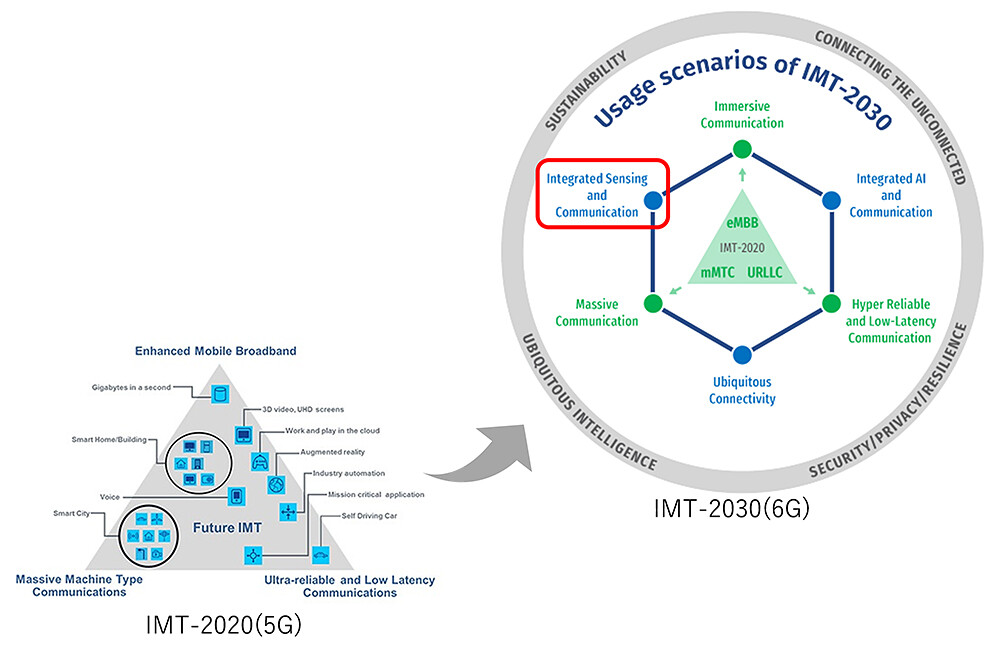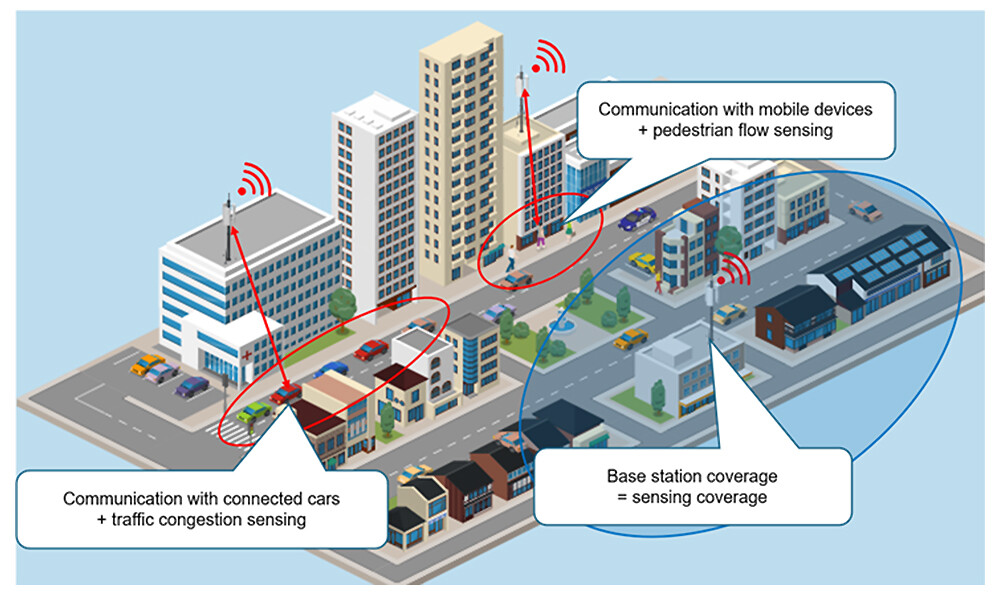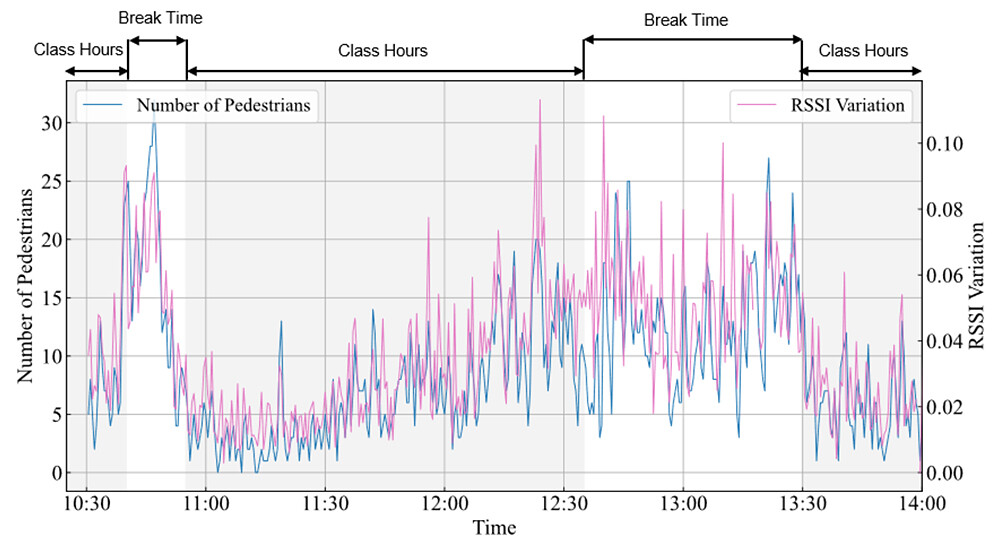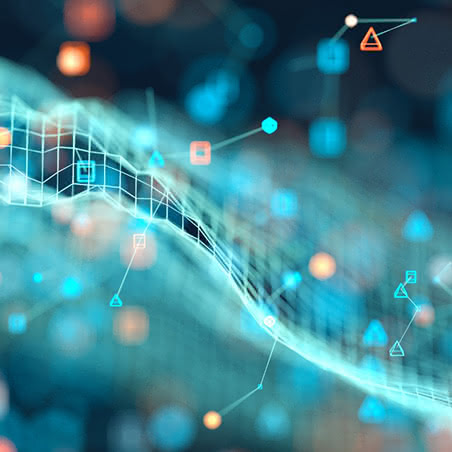Microsoft ends support for Internet Explorer on June 16, 2022.
We recommend using one of the browsers listed below.
- Microsoft Edge(Latest version)
- Mozilla Firefox(Latest version)
- Google Chrome(Latest version)
- Apple Safari(Latest version)
Please contact your browser provider for download and installation instructions.
May 26, 2025
NTT Corporation
Sophia University
World-First Demonstration: Estimating Outdoor Pedestrian Flow from Fluctuations in Mobile Communication System's Radio Signals Using Commercial Base Stations
Advancing toward practical sensing in the 6G era — anywhere covered by base station signals can become a sensing area, using only communication devices
News Highlights:
- We have developed a technology that extracts radio propagation information for sensing applications from synchronization signals, which are essential for connecting communication devices to base stations.
- For the first time in the world, we successfully demonstrated the estimation of the number of people passing outdoors by analyzing commercial base station radio propagation data acquired in a real-life environment using AI.
- This achievement demonstrates the effectiveness of Integrated Sensing and Communications (ISAC), a system expected to be introduced in 6G, and paves the way for new value creation in mobile communication systems, such as pedestrian-flow sensing without the need for cameras or dedicated sensors.
TOKYO - May 26, 2025 - NTT Corporation (Headquarters: Chiyoda, Tokyo; President and CEO: Akira Shimada; hereinafter "NTT") and Sophia University (Headquarters: Chiyoda, Tokyo; President: Miki Sugimura) have achieved a world-first demonstration of human detection by analyzing variations in radio propagation information extracted from synchronization signals transmitted by commercially operated base stations.
This research was conducted to evaluate the effectiveness of ISAC (Integrated Sensing and Communications), which is expected to be adopted in sixth-generation mobile communication systems (6G). By applying AI analysis to propagation data obtained from base station signals, the team successfully detected human presence without requiring any additional sensors.
These results suggest that integrating sensing capabilities into existing mobile communication systems—originally designed solely for communication—can significantly expand their range of applications.
This technology will be exhibited at Wireless Japan × Wireless Technology Park1, to be held from May 28 to 30, 2025.
Background
Sixth-generation mobile communication systems (6G2) are expected to significantly enhance mobile communication systems by enabling ultra-high-speed data transmission, low latency, and massive device connectivity. In line with this, the Radiocommunication Sector of the International Telecommunication Union (ITU-R3) is discussing the standardization of 6G under the framework of IMT-2030 (6G)4, which includes considerations for ISAC (Integrated Sensing and Communications)—a technology that integrates radio communication and sensing (Figure 1).
ISAC enables sensing capabilities using the same radio wave propagation information used for communication, eliminating the need for installing additional dedicated sensing devices. Moreover, since ISAC relies on radio signals rather than optical imaging, it allows for privacy-conscious sensing without capturing images of the target. ISAC is also expected to perform well in environments where conventional cameras struggle—such as in darkness or where line-of-sight is obstructed.
Recognizing these advantages, the 3rd Generation Partnership Project (3GPP5) has defined a wide range of ISAC use cases (Table 2), envisioning the deployment of radio-based sensing across diverse indoor and outdoor environments.
However, most existing experimental validations have been limited to indoor use cases using wireless LAN systems. While theoretical studies on ISAC-based wireless sensing in mobile communication systems are increasing, experimental demonstrations remain scarce. Even when such reports exist, they often rely on experimental base stations or controlled test environments, leaving the practical feasibility of 3GPP-defined ISAC use cases unverified.
Against this backdrop, NTT and Sophia University have been conducting R&D on wireless sensing technologies using commercial base stations, based on the envisioned use cases of ISAC (Figure 3). The wireless propagation information acquisition system developed for this demonstration is capable of collecting data from commercially deployed 4G and 5G networks. Accordingly, this demonstration specifically validated ISAC technology using the most widely deployed 4G commercial base stations in real-life environments.
 Figure 1 Usage Scenarios of IMT-2020 (5G) and IMT-2030 (6G) Published by ITU-R
Figure 1 Usage Scenarios of IMT-2020 (5G) and IMT-2030 (6G) Published by ITU-R
* You can scroll horizontally
| Target | Use Cases | Added Value of ISAC | |
|---|---|---|---|
| Outdoor | Human/ Animals |
|
- No need for cameras or dedicated sensors - Privacy-conscious sensing - Enables sensing at night |
| Vehicles |
|
- No need for cameras or dedicated sensors - Works without line of sight - Enables sensing at night |
|
| UAV |
|
- Enables tracking even when GPS accuracy is poor near buildings - Sensing possible in non-line-of-sight or nighttime conditions |
|
| Weather |
|
- Sensing possible in areas without dedicated weather sensors | |
| Indoor | Factories |
|
- No need for dedicated sensors - Sensing not affected by line of sight or lighting conditions |
| Home |
|
- No need for cameras or dedicated sensors - Privacy-conscious sensing - Sensing not affected by lighting conditions |
Table 2 ISAC Use Cases Specified by 3GPP
 Figure 3 Conceptual Illustration of ISAC Applications
Figure 3 Conceptual Illustration of ISAC Applications
Experimental Environment and Results
NTT and Sophia University have developed a system that utilizes synchronization signals periodically transmitted from commercial base stations to extract radio propagation information. Using this system, a field demonstration was conducted to sense the number of pedestrians on an outdoor pathway at the Yotsuya Campus of Sophia University.
(1) Experimental Environment
In this demonstration, pedestrian detection in an outdoor setting—one of the ISAC use cases—was conducted on Sophia University's Yotsuya Campus.
Radio signals transmitted from commercial base stations installed and operating on campus were received using two antennas positioned along a campus walkway. These signals were then analyzed using the developed wireless sensing system (Figure 4).
The radio signals used for analysis came from the 2 GHz Band 1 of a 4G system. From the signals, Received Signal Strength Indicator (RSSI) and Channel State Information (CSI) were extracted and used for sensing.
The measurement period spanned 3.5 hours, from 10:30 AM to 2:00 PM, including both low-traffic lecture hours and high-traffic lunch breaks.
In addition to the wireless sensing system, a camera installed on campus was used to obtain ground truth pedestrian counts. Specifically, the number of people passing through the green-highlighted area shown in Figure 4 was counted from the camera footage6, enabling simultaneous collection of radio signal data and pedestrian data.
 Figure 4 Experimental Environment (Sophia University Yotsuya Campus)
Figure 4 Experimental Environment (Sophia University Yotsuya Campus)
(2) Experimental Results
- Time Series of Moving Variance of RSSI
Figure 5 shows the number of pedestrians observed (blue line) and the moving variance of RSSI extracted from 4G signals using the wireless sensing system (pink line), measured between 10:30 AM and 2:00 PM.
The graph reveals a clear pattern: fewer pedestrians during lecture hours (when students are in classrooms), and more during lunch breaks (when students move between buildings).
The variance of RSSI showed a trend closely resembling the pedestrian count. - AI-Based Pedestrian Count Estimation
Figure 6 presents results of pedestrian count estimation using deep learning-based AI analysis.
RSSI, representing the strength of received signals, is lightweight in terms of processing and can be measured 100 times per second.CSI, which captures amplitude and phase information across multiple subcarriers and antennas, provides spatial information but is high-dimensional and computationally intensive—thus limited to about one measurement per second when using synchronization signals from commercial base stations.
Since both temporal and spatial information are important for estimating crowd density, this demonstration used both RSSI and CSI in deep learning.
For preprocessing:RSSI: Moving standard deviation was calculated over multiple time windows to capture various pedestrian movement patterns.
CSI: Variations across antennas and subcarriers were computed to extract spatial features.Deep learning models were trained to extract temporal features from RSSI and spatial features from CSI, which were then combined to estimate pedestrian counts.
Outdoor environments are subject to noise such as wind-induced movement, which can degrade model generalization.
To address this, data augmentation techniques were applied by adding noise to the observed values and ground truth labels7, helping to prevent overfitting8.Figure 6 shows that using moving standard deviation of RSSI, spatial information from CSI, and data augmentation significantly reduced estimation error—cutting it by half.
 Figure 5 Trends in Pedestrian Count and Moving Variance of RSSI
Figure 5 Trends in Pedestrian Count and Moving Variance of RSSI
Note. The blue line represents the number of pedestrians over time, while the pink line indicates the moving variance of the Received Signal Strength Indicator (RSSI). The left vertical axis corresponds to the pedestrian count, and the right vertical axis corresponds to the RSSI moving variance. Gray-shaded areas indicate class hours, and white-shaded areas indicate break times.
 Figure 6 Pedestrian Count Estimation Results
Figure 6 Pedestrian Count Estimation Results
Roles of Each Organization
NTT:
Developed the wireless sensing system to measure synchronization signals transmitted.
From operational commercial base stations. Verified the effectiveness of wireless sensing technology using deep learning.
Sophia University:
Provided the experimental environment (Yotsuya Campus, Sophia University), performed pedestrian counting using cameras, and created the pedestrian count dataset. Evaluated useful RSSI features for estimating pedestrian numbers.
Future Developments
This demonstration successfully showcased the practicality of ISAC (Integrated Sensing and Communications), where sensing can be achieved solely through communication devices within the coverage area of commercial base station signals. Since the wireless sensing system developed in this study can utilize both 4G and 5G signals, ISAC can be demonstrated in real-world environments even before the rollout and widespread adoption of 6G.
Moving forward, we will continue to conduct ISAC demonstration experiments for various real-life use cases using commercial 4G and 5G signals, further advancing ISAC technology research and development. The results obtained will be submitted to 3GPP to promote the standardization and practical implementation of ISAC in 6G. In addition, we plan to explore technologies for integrating and analyzing synchronization signals from base stations of multiple mobile operators, aiming to further enhance sensing accuracy.
Our goal is to verify and explore service applications using ISAC technology toward its realization around 2030, when 6G is expected to be widely deployed.
[Glossary]
1Wireless Japan × Wireless Technology Park
https://wjwtp.jp/2025/en/
26G: Abbreviation for the sixth-generation mobile communication system, a next-generation wireless standard expected to offer ultra-high-speed, ultra-low-latency, and massive connectivity.
3ITU-R: The Radiocommunication Sector of the International Telecommunication Union (ITU), a specialized agency of the United Nations. ITU-R is responsible for revising the Radio Regulations (international rules for radio communication), studying technical and operational issues, issuing recommendations, and allocating/registering radio frequencies.
4IMT2030 (6G): Stands for International Mobile Telecommunications 2030, the proposed standard for 6G mobile communication technologies.
53GPP: Abbreviation for the 3rd Generation Partnership Project, a global collaborative project that develops international standards for mobile communication systems.
6Approved by the Human Research Ethics Committee at Sophia University (Application No.: 2023-152, 2024-202).
7Labeled data used for training machine learning models. In this demonstration, observed values (RSSI and CSI) were matched with labels (pedestrian counts derived from camera images) based on timestamps.
8Overfitting: A condition in machine learning where the model performs well on the training data but poorly on unseen data. This often occurs when a model is overly complex relative to the amount and variability of the training data.
About NTT
NTT contributes to a sustainable society through the power of innovation. We are a leading global technology company providing services to consumers and businesses as a mobile operator, infrastructure, networks, applications, and consulting provider. Our offerings include digital business consulting, managed application services, workplace and cloud solutions, data center and edge computing, all supported by our deep global industry expertise. We are over $90B in revenue and 340,000 employees, with $3B in annual R&D investments. Our operations span across 80+ countries and regions, allowing us to serve clients in over 190 of them. We serve over 75% of Fortune Global 100 companies, thousands of other enterprise and government clients and millions of consumers.
Media contacts
NTT Information Network Laboratory Group
Public Relations
Inquiry Form
Sophia University
<1> For inquiries regarding the research
Masakatsu Ogawa, Professor
Department of Information and Communication Sciences, Faculty of Science and Technology
m-ogawa@sophia.ac.jp
<2> For media inquiries
Office of Public Relations, Sophia School Corporation
sophiapr-co@sophia.ac.jp
Information is current as of the date of issue of the individual press release.
Please be advised that information may be outdated after that point.
NTT STORY
WEB media that thinks about the future with NTT










